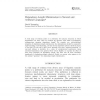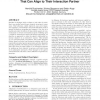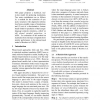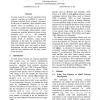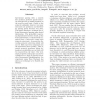JQL
2008
14 years 4 months ago
2008
A wide range of evidence points to a preference for syntactic structures in which dependencies are short. Here we examine the question: what kinds of dependency configurations min...
ATAL
2010
Springer
14 years 5 months ago
2010
Springer
Speakers in dialogue tend to adapt to each other by starting to use similar lexical items, syntactic structures, or gestures. This behaviour, called alignment, may serve important...
COLING
1996
14 years 5 months ago
1996
The objective of this pal)er is to [brmalize the intuition al)out l,he comph;xity of syntactic structures. We propose a definition of structm:al COml)h'xity such that sentenc...
IJCAI
2001
14 years 6 months ago
2001
In this paper, we present a quantitative comparison between the syntactic structures of three languages: English, Chinese and Korean. This is made possible by first extracting Lex...
EMNLP
2006
14 years 6 months ago
2006
This paper proposes a statistical, treeto-tree model for producing translations. Two main contributions are as follows: (1) a method for the extraction of syntactic structures wit...
EMNLP
2004
14 years 6 months ago
2004
In most research on concept acquisition from corpora, concepts are modeled as vectors of relations extracted from syntactic structures. In the case of modifiers, these relations o...
LREC
2008
14 years 6 months ago
2008
Treatment of Multiword Expressions (MWEs) is one of the most complicated issues in natural language processing, especially in Machine Translation (MT). The paper presents dictiona...
COST
2008
Springer
14 years 6 months ago
2008
Springer
In the present study, selected properties of multimodal instructing acts are discussed. Realisations of the instructing acts extracted from a corpus of task-oriented dialogues are ...
NLPRS
2001
Springer
14 years 9 months ago
2001
Springer
Incremental parsing with a context free grammar produces partial syntactic structures for an initial fragment on the word-by-word basis. Owing to the syntactic ambiguity, however,...
ICTAI
2003
IEEE
14 years 10 months ago
2003
IEEE
Many natural language processing approaches at various complexity levels have been reported for extracting biochemical interactions from MEDLINE. While some algorithms using simpl...
